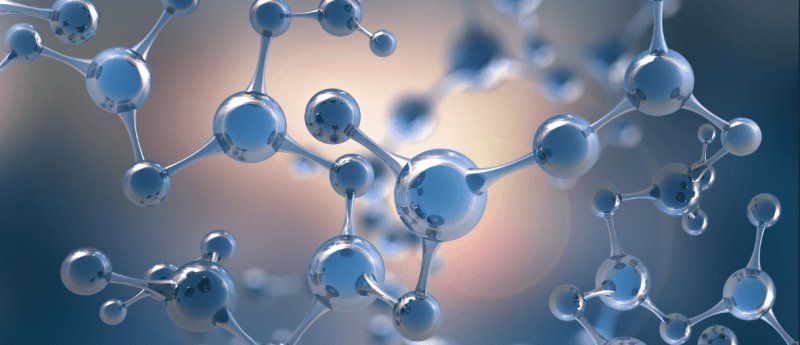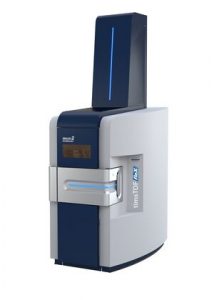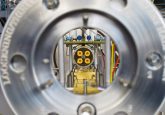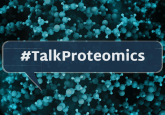First commercial MALDI-2 source and latest Bruker innovations announced at ASMS 2020 Reboot

Bruker (MA, USA) have announced the first commercially available matrix-assisted laser desorption ionization-2 (MALDI-2) post ionization source at the virtual ASMS 2020 Reboot event. The new MALDI-2 technology – which will be available as an option on the timsTOF flex™ ESI/MALDI mass spectrometer – allows increases of up to two orders of magnitude in sensitivity and selectivity compared with MALDI.
Stay up-to-date with all of our ASMS 2020 content, including news, interviews and our highlights. Click here.
Bruker believe that the increased sensitivity and selectivity of the new MALDI-2 technology, and the ability to carry out comprehensive untargeted monitoring of metabolites will make it and important development for pharma, biopharma and translational researchers.

timsTOF fleXTM ESI/MALDI mass spectrometer. Image courtesy of Bruker.
On the subject of the MALDI-2 technology – which will begin shipping in early Q4 2020 – Michael Easterling (Global MS Imaging Director, Bruker Daltonics) explained: “The growing value of MALDI Imaging and SpatialOMx for tissue-specific models in drug development drives demand for even higher sensitivity and versatility. With its dramatically increased sensitivity and accessible range of chemical classes, the novel MALDI-2 source option can now further enhance mass spectrometry-based, non-targeted tissue analysis.”
As well as the latest generation of MALDI technology, Bruker announced a variety of 4D proteomics developments for the timsTOF platform. These include the combination of the PASEF® (parallel accumulation serial fragmentation) acquisition mode with parallel reaction monitoring to facilitate enhanced translational quantitative proteomics.
The latest innovations in the timsTOF platform use measurements of tens of thousands of peptide collisional cross sections to give an additional dimension to peptide identification, improving confidence. Bruker highlighted a recent preprint submitted to bioRxiv, in which researchers use a deep learning training set of over half a million collisional cross section values measured in 360 LC–MS runs of fractionated digests of five organisms, run on a timsTOF Pro system.
Matthias Mann (Director of the Max Planck Institute of Biochemistry, Planegg, Germany) stated: “The size and shape of peptide ions in the gas phase are an under-explored dimension for mass spectrometry-based proteomics. Collisional cross section values can now be predicted for any peptide and organism, forming a basis for advanced proteomics workflows that make full use of the additional information.”
Bruker believe that the ability to carry out large scale, highly sensitive and highly robust measurements of the collisional cross sections for tens of thousands of peptides per 4D nano LC-collision cross section-MS/MS run will prove to be important for scientists working in the omics sciences.
Further developments have been made to facilitate high throughput proteomics, with Bruker announcing ‘Run & Done’, a search tool developed in collaboration with Integrated Proteomics Applications (IPA, CA, USA).
The ‘Run & Done’ software is an integration of the proteomic pipeline, IP2, developed by Robin Park (IPA), integrated to a GPU-based search engine capable of performing real-time searches of the ProLuCID database developed by the Yates Lab (The Scripps Institute, CA, USA) as acquisition is taking place.
John Yates (The Scripps Institute and IPA) and Robin Park explained: “The co-evolution of computational advances with mass spectrometry sensitivity and scan speed have enabled more accurate, large-scale data analysis approaches that help answer many biological questions. GPU-based search engines designed to simultaneously execute many parallel instruction threads can reduce search times to the point where the search results can be converted into real-time input to drive tandem MS acquisition. This becomes an exciting part in our partnership with Bruker, as it will utilize the timsTOF Pro even more intelligently.”
Bruker are scheduled to host a variety of symposia and breakfast events highlighting the latest technological innovations and products during the virtual ASMS 2020 Reboot conference.
Sources: www.bruker.com/news/asms/bruker-asms-2020-press-release.html; https://www.bruker.com/events/2020/asms-2020-reboot.html





